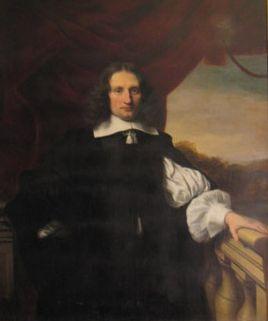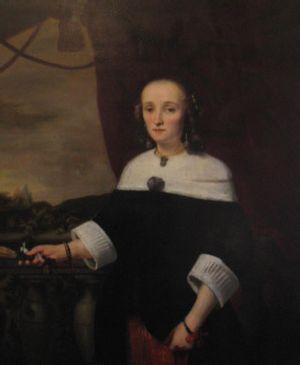6. Assessment of the dispute
6.1 The Committee ascertained that no final settlement had been reached in the dispute between the applicant and the municipality, having found no evidence of legal proceedings or a court ruling in connection with the works. Nor has the applicant previously expressly waived her rights to the works. The Committee therefore deems the application by the parties to be admissible.
6.2 The applicant maintained that she is the sole heir of Gustaaf Hamburger. She submitted the following documents to support this:
1. A document drawn up in Geneva on 12 February 1980 and stamped by the General Consulate of the Federal Republic of Germany, signed by AA and consul Johann Wenzl, containing a declaration under oath in which the applicant is named as her father’s sole heir;
2. A certificate of inheritance, executed before René Tcheraz, civil-law notary in Geneva, dated 17 October 1977, regarding the estate of Gustaaf Hamburger, in which AA is named as her father’s sole heir (the applicant’s surname is stated here as HH);
3. A document, dated 5 January 1981, concerning a compensation procedure with the Directorate for Financial Administration of Federal Properties in Berlin, regarding the assets of Gustaaf Hamburger, in which the applicant is identified as the sole heir (‘Alleinerbin’).
In addition as part of an earlier request for advice in relation to Hamburger (RC 1.130) the Committee was made aware of a certificate of inheritance, executed on 19 August 2013 before M.R. Meijer, civil-law notary in Amsterdam, in which it is stated that Gustaaf Hamburger left the applicant as his sole heir.
These documents constitute evidence that the applicant is the sole beneficiary to the estate of Gustaaf Hamburger.
6.3 The Committee considered the question as to whether it is highly plausible that Gustaaf Hamburger was in fact the owner of the works at the time of the alleged involuntary loss of ownership. It has been established that the works were auctioned at the Amsterdam auction house Frederik Muller & Cie on 7 December 1938. The SNK claim form completed by Hamburger on 31 October 1945 states under ‘Provenance’:
‘Auction Fred.Muller 6-7 Dec. 1938 (Knoops) / originally Galerie Grand Duc de Oldenburg’.
Attached to the form is a cutting from the auction catalogue which accompanied the aforementioned auction describing the two works, as well as a page from the auction catalogue showing pictures of the works.
It has equally been established that the works were sold during the war at the auction held at Mak van Waay between 6 and 9 April 1943. The works were put up for auction by H. Bok, an employee of the bank who also performed activities for the art dealership during the occupation.
Given the above the Committee believes it can be assumed that the works were purchased by Hamburger at the 1938 auction and that the works were put up for auction on his behalf by H. Bok at the Mak van Waay auction in 1943.
The Committee considered the possibility that the works were not part of Hamburger’s private property but were instead assets belonging to the art dealership or the bank. For example the Mak van Waay purchase and sale registers state that the two paintings were put up for auction by ‘H. Bok’, with the additional note: ‘N.V. tot Uitoefening van den Kunsthandel’. Conversely a list attached to a letter dated 19 September 1945 from R.G. Somers, acting director of the bank, to SNK includes two objects which in the Committee’s opinion can be identified as the works which are the subject of this claim. The list in question, ‘List B’, is headed ‘Art objects sold to Dutch parties by N.V. tot Uitoefening van den Kunsthandel or Hamburger & Co’s Bankierskantoor N.V.’
In spite of these references the Committee assumes that it is highly plausible that the works were part of Hamburger’s private property at the time of their auction by Mak van Waay.
Firstly important to this is that Hamburger stated on the aforementioned SNK claim form that the works were originally in his ownership. It can be deduced from correspondence between Hamburger and Somers on the one hand and SNK on the other, as described on pp. 24-26 of the Research Report finalised on 13 April 2015, that Hamburger only completed this form, as well as other claim forms, after he (Hamburger) had at the request of SNK director A.B. de Vries examined more closely whether the works belonged to his private property, the assets of the art dealership or the property of Herman Hamburger.
Secondly important to this is that it can be derived from documents found that Hamburger did not only have works of art in his home in Laren, but that it is also likely that items belonging to him were housed at the art dealership and the bank. These probably also included items removed from his home during the occupation for safekeeping. In this context the Committee refers to the letter sent to Hamburger by art dealer Evert Douwes on 8 August 1945 on behalf of the Ministry of Education, Arts and Sciences, in which he wrote to Hamburger that his brother, Albert, had had the opportunity to remove many objects from Hamburger’s home during the occupation and take them to the art dealership’s premises.
In light of the above the Committee arrives at the opinion that it is highly plausible that the works belonged to the private property of Gustaaf Hamburger at the time of the alleged involuntary loss of ownership.
6.4 As far as the nature of the loss of ownership is concerned the Committee believes that this should be considered to have been involuntary. At the time of the auction by Mak van Waay Hamburger was in New York. As an employee of the bank the person who put the works up for auction, H. Bok, was involved in the liquidation of the property of the Hamburger family by order of the German Verwalter. The Committee found no evidence whatsoever that Hamburger himself was in any way involved in the decision to put the works up for auction by Mak van Waay. Furthermore Hamburger stated on the SNK form he completed that a ‘forced sale’ was involved. Under these circumstances the Committee believes the loss of ownership should be deemed to have been involuntary and the result of circumstances directly connected with the Nazi regime.
6.5 Under Dutch law it must be assumed that the municipality is the current owner of the works. The municipality purchased the works in 1949 from the Veldkamp estate.
Although the municipality was aware of Veldkamp’s political orientation, it was not known where or when he had acquired these works. Nor was the municipality aware of the fact that Hamburger had reported the loss of the works to SNK after the war. The Committee has no indication that the municipality acted without due care in making this purchase.
6.6. Now the Committee must proceed with weighing the interests of the parties in the event of restitution or retention of the works. The municipality has argued that the works are permanently on display at the Museum and are among the star items in the collection there. In addition the works play a part in an annual educational programme for schoolchildren about the 17th century. The municipality tried to have the works auctioned in 2004, but they remained unsold. The Committee notes that, in light of the renewed interest in Nazi-looted art since the late 1990s and given the provenance information available about the works at the time of this auction in 2004, the municipality could have decided to conduct further research into the provenance of the works.
In the Committee’s opinion it can be concluded from the fact that the municipality tried to sell the works in 2004 that the municipality has a limited interest in retaining the works. This interest of the municipality must be weighed against the interest of the applicant in the event of restitution of the works. The applicant is the daughter of the original owner, who lost ownership of the works involuntarily. Directly after the war Hamburger reported the involuntary loss of ownership of the works that are the subject of this claim to SNK and following his death the applicant undertook to track down works from his art collection. In light of this the Committee considers the interest of the applicant in the event of restitution of the works to outweigh the interest of the municipality in the event of retention of the works.
6.7 The Committee considered the question of whether the surrender of the works should be subject to compensation from the applicant. The municipality purchased the works in 1949 out of the Veldkamp collection. The collection was originally valued at NLG 60,000, with the two works accounting for NLG 5,000 of this. The asking price for the entire collection was eventually lowered to NLG 35,000, with the provision that the Veldkamp heirs were to be allowed to take NLG 10,000 worth of objects out of the collection. The remaining objects were acquired by the municipality for a sum of NLG 25,200. It is not known what the share of the two works was in this amount, but the sale value was in no case higher than NLG 5,000 and most likely lower. Furthermore the municipality has maintained that it incurred costs in connection with looking after and restoring the works. It can be deduced from documents submitted by the municipality that restoration work at an estimated cost of around NLG 2,000 was performed in 1967.
Although it proved impossible to determine the precise purchase price of the works, the Committee believes that a relatively small sum was concerned. The same applies to the restoration costs quoted by the municipality. These amounts paid by the municipality are balanced by the fact that the municipality has had the enjoyment of these works since 1949. Under these circumstances the Committee sees no reason for making surrender of the works subject to compensation from the applicant.
6.8 The municipality also stated that it wished to obtain clarity on what happened to the proceeds of the auction of the works by Mak van Waay. On this subject the Committee notes that indications emerged from the research that the proceeds from the works were received, but that it is not sufficiently clear that these proceeds were made freely available to Hamburger, so that for this reason alone there is no cause for the proceeds from the works to be taken into account in this binding opinion.
6.9 As regards the settlements between the Hamburger heirs and the German State the Committee considers that these related to confiscated goods and as such in all probability not to the two works that are the subject of this claim. These settlements therefore have no bearing on the content of this binding opinion.
6.10 Based on the above the Committee advises the restitution of the works to the applicant. The Committee sees the exceptional circumstances of this case with regard to the original ownership, as set out by the Committee in point 6.3, as reason to make restitution of the works conditional upon the applicant indemnifying the municipality against potential, as yet unknown claims which claimants may make in regard to the assets of the bank and the art dealership. The parties have let it be known that they have no objections to such indemnification.

